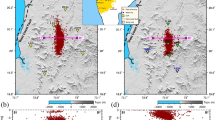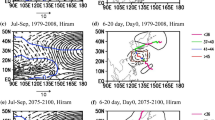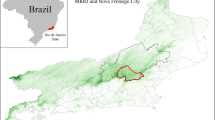Abstract
A squall line on 14 June 2009 in the provinces of Jiangsu and Anhui was well simulated using the Advanced Regional Prediction System (ARPS) model. Based on high resolution spatial and temporal data, a detailed analysis of the structural features and propagation mechanisms of the squall line was conducted. The dynamic and thermodynamic structural characteristics and their causes were analyzed in detail. Unbalanced flows were found to play a key role in initiating gravity waves during the squall line’s development. The spread and development of the gravity waves were sustained by convection in the wave-CISK process. The squall line’s propagation and development mainly relied on the combined effect of gravity waves at the midlevel and cold outflow along the gust front. New cells were continuously forced by the cold pool outflow and were enhanced and lifted by the intense upward motion. At a particular phase, the new cells merged with the updraft of the gravity waves, leading to an intense updraft that strengthened the squall line.
Similar content being viewed by others
References
Biggerstaff, M. I., and R. A. Houze Jr., 1991: Kinematic and precipitation structure of the 10–11 June 1985 squall line. Mon. Wea. Rev., 119, 3034–3065.
Biggerstaff, M. I., and R. A. Houze Jr., 1993: Kinematics and microphysics of the transition zone of the10–11 June 1985 suqall line. J. Atmos. Sci., 50, 3091–3110.
Bosart, L. F., and J. P. Cussene, 1986: Mesoscale structure in the megalopolitan snowstorm of 11-12 February 1983 Part III: A large-amplitude gravity wave. J. Atmos. Sci., 43, 924–939.
Braun, S. A., and R. A. Houze Jr., 1994: The transition zone and secondary maximum of radar reflectivity behind a midlatitude squall line: Results retrieved from Doppler radar data. J. Atmos. Sci., 51, 2733–2755.
Brown, J. M., 1979: Mesoscale unsaturated downdrafts driven by rainfall evaporation: A numerical study. J. tAtmos. Sci., 36, 313–338.
Browning, K. A., and F. H. Ludlam, 1962: Airflow in convective storms. Quart. J. Roy. Meteor. Soc., 88, 117–135.
Bryan, G. H., J. C. Knievel, and M. D. Parker, 2006: A multimodel assessment of RKW theory’s relevance to squall-line characteristics. Mon. Wea. Rev., 134, 2772–2792.
Cahn, A. Jr, 1945: An investigation of the free oscillations of a simple current system. J. Meteor., 2, 113–119.
Cai, Z. Y., H. Z. Li, and H. A. Li, 1988: Structure and evolution of squall line systems in North China. Chinese J. Atmos. Sci., 12, 191–199. (in Chinese)
Chen, M. X., and Y. C. Wang, 2012: Numerical simulation study of interactional effects of the low level vertical wind shear with the cold pool on a squall line evolution in North China. Acta Meteorologica Sinica, 70, 371–386. (in Chinese)
Curry, M. J., and R. C. Murty, 1974: Thunderstorm-generated gravity waves. J. Atmos. Sci., 31, 1402–1408.
Davis, C. A., and K. A. Emanuel, 1991: Potential vorticity diagnosis of cyclogenesis. Mon. Wea. Rev., 119, 1929–1952.
Fovell, R. G., and Y. Ogura, 1988: Numerical simulation of a midlatitude squall line in two dimensions. J. Atmos. Sci., 45, 3846–3879.
Fovell, R. G., 2002: Upstream influence of numerically simulated squall line storms. Quart. J. Roy. Meteor. Soc., 128, 893–912.
Fovell, R. G., and Y. Ogura, 1989: Effects of vertical wind shears on numerically simulated multicell storm structure. J. Atmos. Sci., 46, 3144–3176.
Fritsch, J. M., and C. F. Chappell, 1980: Numerical prediction of convectively driven mesoscale pressure systems, Part I: Convective parameterization. J. Atmos. Sci., 37, 1722–1733.
Fujita, T. T., 1955: Results of detailed synoptic studies of squall lines. Tellus, 7, 405–436.
Gallus, W. A. Jr., N. A. Snook, and E. V. Johnson, 2008: Spring and summer severe weather reports over the Midwest as a function of convective mode: A preliminary study. Wea. Forecasting, 23, 101–113.
Gao, S. T., X. R. Wang, and Y. S. Zhou, 2004: Generation of generalized moist potential vorticity in a frictionless and moist adiabatic flow. Geophys. Res. Lett., 31, doi: 10.1029/2003GL019152.
Gao, S. T., Y. Zhou, T. Lei, and J. Sun, 2005: Analyses of hot and humid weather in Beijing city in summer and its dynamical identification. Science China Earth Sciences, 48, 128–137.
Gao, S. T., S. Yang, and B. Chen, 2010: Diagnostic analyses of dry intrusion and nonuniformly saturated instability during a rainfall event. J. Geophys. Res.: Atmos., 115(D2), doi: 10.1029/2009JD012467.
Gong, X. L., Z. M.Wu, and G. Fu, 2005: Analysis of the mesoscale characteristics about a severe thunderstorm in North China. Chinese J. Atmos. Sci., 29, 453–464. (in Chinese)
He, Q. Q., H. C. Lu, and M. Zhang, 1992: A mesoscale study of squall line in warm sec-tor of Jiang-Huai area. Acta Meteorologica Sinica, 50, 290–300. (in Chinese)
Houze, R. A., Jr, M. I. Biggerstaff, S. A. Rutledge, and B. F. Smull, 1989: Interpretation of Doppler weather radar displays of midlatitude mesoscale convective systems. Bull. Amer. Meteor. Soc. 70, 608–619.
Howard, L. N., 1961: Note on paper of John W. Miles. J. Fluid Mech., 10, 509–512.
Johnson, R. H., and P. J. Hamilton, 1988: The relationship of surface pressure features to the precipitation and the airflow structure of an intense midlatitude squall line. Mon.Wea. Rev., 116, 1444–1472.
Kaplan, M. L., and V. M. Karyampudi, 1992: Meso-bata scale numerical simulations of terrain drag-induced along-stream circulations. Part II: Concentration of potential vorticity within dryline bulges. Meteor. Atmos. Phys., 49, 157–185.
Koch, S. E., and P. B. Dorian, 1988: A mesoscale gravity wave event observed during CCOPE. Part III: Wave environment and probable source mechanisms. Mon.Wea. Rev., 116, 2570–2592.
Koch, S. E., and Coauthors, 2005: Turbulence and gravity waves within an upper-level front??J. Atmos. Sci., 62, 3885–3908.
Lafore, J. P., and M. W. Moncrieff, 1989: A numerical investigation of the organization and interaction of the convective and stratiform regions of tropical squall lines. J. Atmos. Sci., 46, 521–544.
LeMone, M. A., 1983: Momentum flux by a line of cumulonimbus. J. Atmos. Sci., 40, 1815–1834.
Li, M. C., 1976: The nonlinear process of squall line formation. Science China (A), 6, 592–601. (in Chinese)
Li, M. C., 1978: The role of gravity wave in torrential rain. Chinese J. Atmos. Sci., 2, 201–209. (in Chinese)
Li, M. C., 1981: The nonlinear process of squall line formation and KDV equation. Science China, 3, 341–350. (in Chinese)
Mastrantonio, G., F. Einaudi, and D. Fua, 1976: Generation of gravity waves by jet streams in the atmosphere. J. Atmos. Sci., 33, 1730–1738.
Milbrandt, J. A. and M. K. Yau, 2005a: A multi-moment bulk microphysics parameterization. Part I: Analysis of the role of the spectral shape parameter}. J. Atmos. Sci., 62, 3051–3064.
Milbrandt, J. A. and M. K. Yau, 2005b: A multi-moment bulk microphysics parameterization. Part II: A proposed threemoment closure and scheme description. J. Atmos. Sci., 62, 3065–3081.
Miles, J. W., 1961: On the stability of heterogeneous shear flows. J. Fluid Mech., 10, 496–508.
Moore, J. T., and W. A. Abeling, 1988: A diagnosis of unbalanced flow in upper levels during the AEV-SESAME I period. Mon. Wea. Rev., 116, 2425–2436.
Newton, C. W., 1966: Circulations in large sheared cumulonimbus. Tellus, 18, 699–743.
Newton, C. W., 1950: Structure and mechanism of the prefrontal squall line. J. Meteor., 7, 210–222.
Parker, M. D., and R. H. Johnson, 2000: Organizational modes of midlatitude mesoscale convective systems. Mon. Wea. Rev., 128, 3413–3436.
Raymond, D. J., 1983: Waves-CISK in mass flux form. J. Atmos. Sci., 40, 2561–2572.
Raymond, D. J., 1984: A Wave-CISK model of squall lines. J. Atmos. Sci., 41 1946–1958.
Rossby, C. G., 1938: On the mutual adjustment of pressure and velocity distributions in certain simple current systems II. J. Mar. Res., 1, 239–263.
Rotunno, R., J. B. Klemp, and M. L. Weisman, 1988: A theory for strong long-lived squall lines. J. Atmos. Sci., 45, 463–484.
Roux, F., J. Testud, M. Payen, and B. Pinty, 1984: West African squall line thermodynamic structure retrieved from dual- Doppler radar observations. J. Atmos. Sci., 41, 3104–3121.
Shou, S. W., L. L. Shen, and X. P. Yao, 2003: Mesoscale Meteorology. China Meteorological Press, Beijing, 370 pp. (in Chinese)
Smull, B. F., and R. A. Houze Jr., 1985: A midlatitude squall line with a trailing region of stratiform rain: Radar and satellite observations. Mon. Wea. Rev., 113, 117–133.
Smull, B. F., and R. A. Houze Jr., 1987: Rear inflow in squall lines with trailing stratiform precipitation. Mon. Wea. Rev., 115, 2869–2889.
Stobie, J. G., F. Einaudi, and L. W. Uccellini, 1983: A case study of gravity waves convective storms interaction 9 May 1979. J. Atmos. Sci., 40, 2804–2830.
Sun, H. L., Y. L. Luo, R. H. Zhang, L. P. Liu, and G. L. Wang, 2011: Analysis on the mature-stage features of the severe squall line occurring over the Yellow River and Huaihe Riber basins during 3–4 June 2009. Chinese J. Atmos. Sci., 35, 105–120. (in Chinese)
Trier, S. B., W. C. Skamarock, M. A. Lemome, and D. B. Parsons, 1996: Structure and evolution of the 22 February 1993 TOGA COARE squall line: Numerical simulations. J. Atmos. Sci., 53, 2861–2886.
Wang, X. F., B. W. Hu, and C. Li, 2010: Observation study and numerical simulation of the structure for a squall line case in Hubei. Plateau Meteorology, 29, 471–485. (in Chinese)
Wakimoto, R. M., 1982: Life cycle of thunderstorm gust fronts as viewed with Doppler radar and rawinsonde data. Mon. Wea. Rev., 110, 1060–1082.
Weisman, M. L., 1992: The role of convectively generated rearinflow jets in the evolution of long-lived mesoconvectives systems. J. Atmos. Sci., 49, 1826–1847.
Weisman, M. L., 2004: “A theory for strong long-lived squall lines” revisited. J. Atmos. Sci., 61, 361–382.
Weisman, M. L., and R. Rotunno, 2005: Reply. J. Atmos. Sci., 62, 2997–3002.
Weisman, M. L., J. B. Klemp, and R. Rotunno, 1988: Structure and evolution of numerically simulated squall lines. J. Atmos. Sci., 45, 1990–2013.
Wilhelmson, R. B., and C. S. Chen, 1982: A simulation of the development of successive cells along a cold outflow boundary. J. Atmos. Sci., 39, 1466–1483.
Wu, H. Y., H. S. Chen, Y. F. Jiang, L. N. Yao, and S. Y. Cao, 2013: Observation and simulation analyses on dynamical structure features in a severe line process on 3 June 2009. Plateau Meteorology, 32, 1084–1094. (in Chinese)
Xu, X. F., and Z. B. Sun, 2003: Dynamic study on influence of gravity wave induced by unbalanced flow on Meiyu front heavy rain. Acta Meteorologica Sinica, 61, 656–664. (in Chinese)
Yang, M. J., and R. A. Houze Jr, 1995a: Multicell squall-line structure as a manifestation of vertically trapped gravity waves. Mon. Wea. Rev., 123, 641–661.
Yang, M. J., and R. A. Houze Jr, 1995b: Sensitivity of squall-line rear inflow to ice microphysics and environmental humidity. Mon. Wea. Rev., 123, 3175–3193.
Yao, J. Q., J. H. Dai, and Z. Q. Yao, 2005: Case analysis of the formation and evolution of 12 July 2004 severe squall line. Journal of Applied Meteorological Science, 16, 746–754. (in Chinese)
Zack, J. W., and M. L. Kaplan, 1987: Numerical simulations of the subsynoptic features associated with the AVE-SESAME I case Part I: The pre-convective environment. Mon. Wea. Rev., 115, 2367–2394.
Zhang, D. L., and J. M. Fritsch, 1987: Numerical simulation of the meso-scale structure and evolution of the 1987 Johnstown flood. Part III: Internal gravity waves and the squall lin. J. Atmos. Sci., 45, 1252–1268.
Zhang, F., S. E. Koch, C. A. Davis, and M. L. Kaplan, 2000: A survey of unbalanced flow diagnostics and their application. Adv. Atmos. Sci., 17, 165–173, doi: 10.1007/s00376-000-0001-1.
Zhang, F. Q., and S. E. Koch, C. A. Davis, and M. L. Kaplan, 2001: Wavelet analysis and the governing dynamics of a large-amplitude mesoscale gravity-wave event along the east coast of the United States. Quart. J. Roy. Meteor. Soc., 127, 2209–2245.
Zhu, L. L., Z. M. Wu, Q. G. Tai, W. Wei, and J. Y. Zhang, 2009: Analysis of gravity wave characteristics of a strong squall line process in April 2006 in Shandong province. Journal of Tropical Meteorology, 25, 465–474. (in Chinese)
Zipser, E. J., 1977: Mesoscale and convective-scale downdrafts as distinct components of squall-line circulation. Mon. Wea. Rev., 105, 1568–1589.
Zulicke, C., and D. Peters, 2006: Simulation of inertia-gravity waves in a poleward-breaking Rossby wave. J. Atmos. Sci., 63, 3253–3276
Author information
Authors and Affiliations
Corresponding author
Rights and permissions
About this article
Cite this article
Liu, L., Ran, L. & Sun, X. Analysis of the structure and propagation of a simulated squall line on 14 June 2009. Adv. Atmos. Sci. 32, 1049–1062 (2015). https://doi.org/10.1007/s00376-014-4100-9
Received:
Revised:
Accepted:
Published:
Issue Date:
DOI: https://doi.org/10.1007/s00376-014-4100-9




